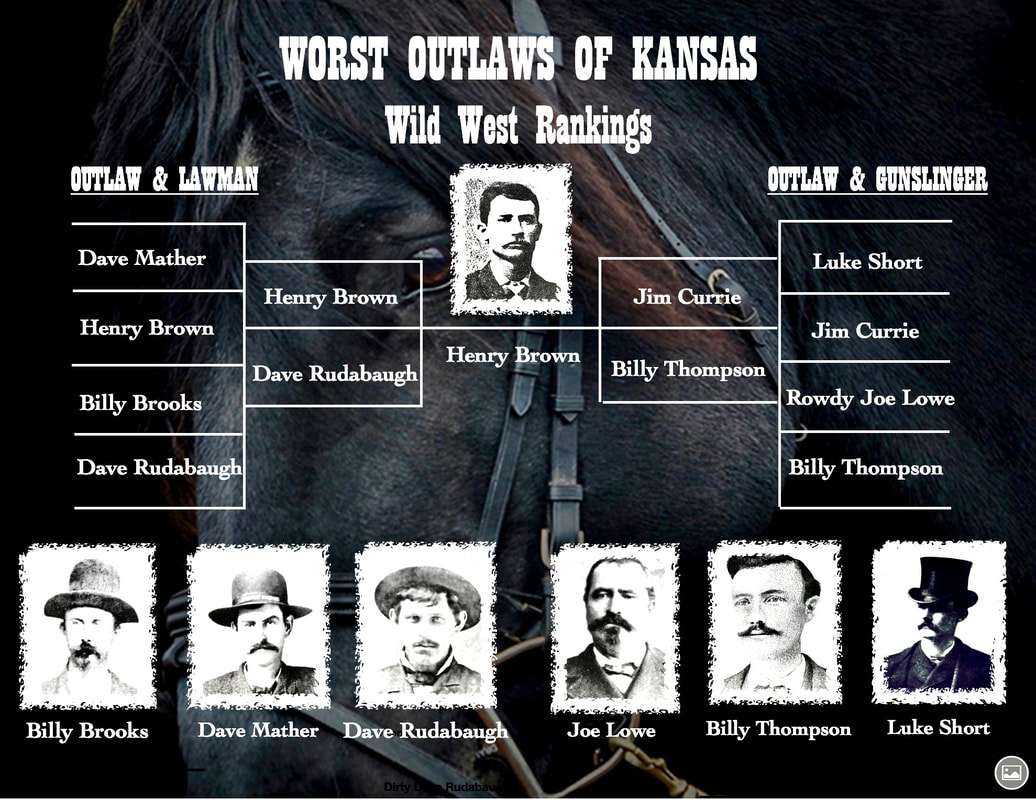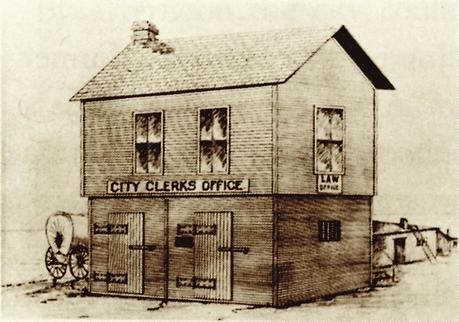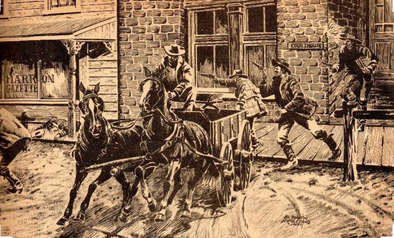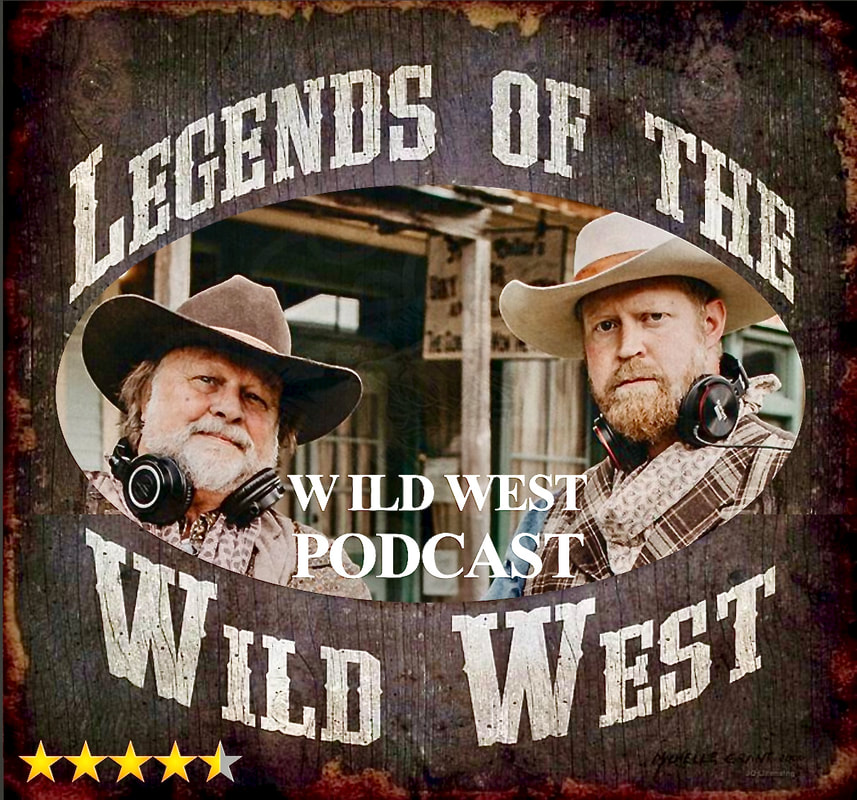Welcome to Wild West Podcast
|
Welcome to Wild West podcast where fact and legend merge. The Wild West Podcast presents the true accounts of individuals, who settled in a town built out of hunger for money, regulated by fast guns, who walked on both sides of the law, patrolling, investing in and regulating the brothels, saloons and gambling houses. These are stories of the men who made the history of the Old West come alive - bringing with them the birth of legends, brought to order by a six-gun and laid to rest with their boots on. Join us now as we take you back in history, to the legends of the Wild West.
|
Kansas Frontier Trilogy
Kansas History
|
The pages of Kansas’ history have been filled with romance and conflict since Coronado and the conquistadors rode across the Plains, seeking Quivira. He and his explorers rode on the first horses ever seen by the Kansas Indians. Coronado, the leader of the first white men to set foot on Kansas soil in 1541, claimed the area with the rest of the western country for Spain. This claimed Territory would stand for nearly a century and a half, supported by other Spanish expeditions that went uncontested.
|
Kansas and the Civil War
|
|
In 1854, Senator Stephen Douglas introduced a bill before Congress for the organization of two territories, Kansas and Nebraska. The territories would be divided by the 40th parallel. In addition, the issue of slavery in the territories would be decided by popular sovereignty instead of by the Missouri Compromise of 1820. Despite fierce opposition in the North by such abolitionists as Horace Greeley and William Lloyd Garrison, the bill passed on May 26, 1854, and was quickly signed by President Franklin Pierce. The Kansas-Nebraska Act reopened the question of extending slavery to new states north of the Missouri Compromise line established in 1820. The Act stipulated that the settlers of the Kansas territory would vote on whether to permit slavery.
|
Worst Outlaws of the Kansas Wild West
|
Manifest destiny, a term created by John Lewis O’Sullivan in 1845, barefaced the idea that God destined the United States to stretch from the Atlantic Ocean to the Pacific Ocean. This philosophy drove 19th-century U.S. territorial expansion and brought floods of people to Kansas, often desiring to attain wealth while far more encountered hardships. In the nineteenth century, striking out to find a new start, a new life, or a new opportunity to expand beyond the bounds of society was no less daunting than traveling across the ocean to find unknown lands. These frontiersmen would do almost anything to survive—some committed robbery and murder to obtain an income.
|
Boomtowns and the sparsely populated frontier became breeding grounds for crime on a scale Kansas had never seen before. Gunfights sometimes became a way to settle disputes in the never-ending struggle of good vs. evil. For some of the first settlers of Kansas, breaking the law became a way of life, and drawing the line between upholding and breaking the law became clouded; it is challenging to tell whether acts of lawlessness were for personal gain or basic survival. Outlaws and lawmen blazed away at each other with revolvers, carbines, and shotguns. Gunslingers, outlaws, and leather slappers all pulled their barking irons, exposing themselves to peril by wearing badges, robbing people, or associating with dangerous men in dangerous places. Sometimes, they did it on both sides of the law, and which side of the badge they were on made it legal, and for the outlaw, it was not.
New: The Intriguing Evolution of Rodeo from Wild West to Professional Sport
|
|
We're venturing back to the mid-1800s, where it all began with Spanish missionaries, Vecarro culture, and the early cowboys whose fierce rivalry sparked the creation of what we now know as professional rodeo. Discover how their roping and riding contests for bragging rights transformed into a recognized sport, with a nod to pioneers like William F. Cody and his entertainment shows, and William Pickett's innovative bull-wrestling technique, bulldogging.
|
We'll also steer you through the various events that have become hallmarks of the professional rodeo - from the rough and tumble of saddle bronc riding and bull riding to the heart-pounding excitement of team roping and barrel racing. Listen as we dissect each event, revealing how their roots lie deep in traditional ranching practices. As we hit the 20th century, join us for a rewind of the first annual Dodge City Rodeo in 1939, and a salute to influential women like Annie Oakley and Mabel Strickland Woodward, who paved the way for women in the sport.
NEW: Guns of the West
|
God did not make all men equal," Westerners were fond of saying, "Colonel Colt did. When it came to the use of shooting irons, however, some men were more equal than others, a fact gunfighters knew well. So, to improve the odds of landing on the right side of this equation, they exercised meticulous care in selecting their firearms from among the weapons available. Wild West Podcast proudly presents Gunfighters and Guns in the Old West, including excerpts from "Wyatt Earp: Frontier Marshall" by Stuart N. Lake.
|
The law of the West comes in the form of a pistol more often than a badge. As a result, those who know how to use it typically ruled the day. As a result, the gunslinger is one of the most feared individuals in the Wild West. Whether lightning fasts with a six-shooter or possessing deadly accuracy with a rifle, a gunslinger knows his craft and is a deadly adversary. July 21, according to American history books, is the anniversary of the first Western gunfight. On this date in 1865, James B. Hickok faced Davis Tutt in Springfield, Missouri. Following an argument over loaned money and a pocket watch, the two men faced each other across the city square. Both men reached for their weapons. Hickok's shot hit Tutt in the chest. The man had enough life left to exclaim, "Boys, I'm killed!" and stagger to the courthouse steps before collapsing.
Indian Wars
|
After the Mexican War of 1846-48, the U.S. government took measures to protect the Santa Fe Trail by establishing several forts along the Arkansas. This was followed by the Mormon exodus to Utah in 1847 and the discovery of gold in California in 1849. The now-endless stream of immigrants on the overland trails brought cholera to the southern plains. Conservative estimates suggest that nearly half of the Cheyenne population perished during the ensuing epidemic; one of the victims was William Bent's wife. With the Indian trade in decline, Bent offered his Adobe fort for sale to the government for use as a military installation. Unable to obtain a satisfactory price, though, he blew up his fort in August 1849 and moved his stores farther down the Arkansas River. Bent relocated near the Big Timbers, where he built a stone fort on the north bank. He leased this compound to the United States in 186o. Originally named FortWise, it became Fort Lyon in 1861.
In 1851 the United States established the boundaries of the Southern Cheyenne, and Arapaho lands in the Treaty of Fort Laramie. The assigned reserve lay roughly between the North Platte and Arkansas rivers, bordered on the west by the Rocky Mountains and east by the Santa Fe Trail crossing of the Arkansas River. The Indians accepted this treaty in consideration of annuities. They pledged to remain at peace, to permit immigration along the trails, and stay within their land's boundaries. The Indians recognized this treaty despite the Senate's ratification that reduced the annuity term from fifty years to fifteen. |
NEW: Trails to the Washita
|
|
The year 1868 was a crucial point in American history, a period rife with conflict and upheaval. This period is the focus of our riveting 6-part podcast series, offering an exhilarating journey back in time.
We'll delve into the visceral realities of Sheridan's winter campaign, taking listeners along the uncharted trails leading to the Battle of the Wachita. It was a time of great struggle between Native American tribes and the encroaching forces of modern civilization. The Native Americans fiercely defended their territories, striving to safeguard their heritage and way of life against the relentless march of progress. |
The series brims with riveting tales and first-person accounts, painting a vivid picture of life in that era. We delve into the return of Custer to active service, a pivotal moment in the campaign. Major Car's skirmish on Beaver Creek is another significant event covered in detail, showcasing the brutal realities of frontier life during the Civil War era.
The Cheyenne Exodus 1878
On June 25, 1876, the Northern Cheyenne were present at the Battle of the Little Big Horn and had contributed to the defeat of General Armstrong Custer's troops. As a result, they were pursued by the U.S. military until they surrendered. One of the conditions of their surrender was that they joined their southern brethren in the Indian Nation at the Darlington Indian Agency.
During the summer of 1877, a large band of approximately one thousand Northern Cheyennes moved southward in the direction of Fort Dodge on their way to Indian Territory. The Cheyennes were being transferred from the Red Cloud Agency of the Dakotas under government supervision. They had participated in the Battle of the Little Big Horn the preceding year. Several braves still wore clothing taken while counting coup against the men of General Custer's United States Seventh Cavalry.
When the Indians camped near Fort Dodge in late July on their way to Camp Supply, many residents of Dodge City turned out to view the red man in his natural state. To complement the residents of Dodge City's visits to Fort Dodge, many of the Cheyennes spent several days in town going door-to-door, begging and periodically performing native dances for the gratification of their curious hosts. Unknown to the Dodge citizens, they would later have a second opportunity to behold many of these same Indians, but under considerably less amicable circumstances.
During the summer of 1877, a large band of approximately one thousand Northern Cheyennes moved southward in the direction of Fort Dodge on their way to Indian Territory. The Cheyennes were being transferred from the Red Cloud Agency of the Dakotas under government supervision. They had participated in the Battle of the Little Big Horn the preceding year. Several braves still wore clothing taken while counting coup against the men of General Custer's United States Seventh Cavalry.
When the Indians camped near Fort Dodge in late July on their way to Camp Supply, many residents of Dodge City turned out to view the red man in his natural state. To complement the residents of Dodge City's visits to Fort Dodge, many of the Cheyennes spent several days in town going door-to-door, begging and periodically performing native dances for the gratification of their curious hosts. Unknown to the Dodge citizens, they would later have a second opportunity to behold many of these same Indians, but under considerably less amicable circumstances.
New: Buffalo Days and Return of the Great Hunters
|
|
Buffalo Days is about outfits of buffalo runners who traveled in and out of the Arkansas River Valley from 1870 to 1874. The book is a collection of individual stories of how men became legends of their experiences, founded at times by luck but mostly on survival skills.
These stories of personal legends were established out of solid character and the will to endure, making them unique to American lore. Here are the hunters such as Charles Rath, Josiah Wright Mooar, Jim White, Thomas Nixon, HooDoo Brown, Bill Tilghman, Bat Masterson, and Billy Dixon. |
The Story of the Second Battle of Adobe Walls
The story “The Return of the Great Hunters” written by Mike King and narrated by Brad Smalley is a six-part series taking place in March of 1874. The buffalo hunters have returned to Dodge City in preparation to travel 150 miles south deep into Indian Territory. Their purpose is to kill off the rest of the southern herd. The expedition is organized by A.C. Myers a Dodge City general merchandising owner who recruits a forty-man team, which ultimately leads to the second battle of Adobe Walls and the Red River War.
The History of Dodge City Kansas
|
|
This Website is dedicated to provide accurate accounts of early Dodge City history as it is thrilling, interesting: and wonderful. The name of Dodge City, Kansas, is known far and wide, and her reputation was not enviable. No city in the United States of the same size has been so thoroughly advertised. To say that one has never heard of Dodge City is to say that he/she does not read. No reader of books, newspapers and magazines can make such an admission. No town of its size in this country has occupied so much time of literary men and writers of books and periodicals.
|
|
Dodge City was founded in 1872 on the plains at the nearest point of the Santa Fe railroad to Fort Dodge. Geographically Dodge City had one of the best locations, and her commanding position enabled the city to maintain the commercial and industrial supremacy. Located on the 100th meridian and fifty miles from the Oklahoma line, about 120 miles east of the Colorado line and on the most southern point on the main line of the Topeka & Santa Fe railroad.
|
Legends of Dodge City
|
We must first ask our self, “What is a Legend?” A legend usually includes an element of truth, or is based on historical facts, but with 'mythical qualities. Our legends are our societal medicine as they are told about in songs and around the campsite, passed on from person to person from generation to generation. Our stories of legends have significant meaning to us. They represent a symbolism for the culture in which it originates.
Our legends are the echoes of us, and we echo them. Perhaps that is why we are so drawn to the stories of our past. These are the stories about the individual, their struggles, and the ability to overcome obstacles as they persevered over time while being played out in the memories of others - who knew them for who they were and what they created. |
NEW: Cattle Drives, Cowboys & Cattle Towns
|
In the fall of 2022, Wild West Podcast will proudly present an all-new series entitled Trails, Cattle Drives, Cowboys, and Cattle Towns. This new series will explore the early cattle trade, relive the challenges of a trail drive, describe the character of the cowboy, and retell the stories of individuals who endured the hardships of the cattle trails of the 1800s. The podcast series will provide Interesting Sketches of Early Cowboys and their Experiences on the Range and on the Trail during the Days that Tried Men's Souls. In addition, the podcast provides True Narratives Related by Real Cow-Punchers and the Men who fathered the cattle industry.
|
|
So make sure you subscribe to our podcast listed at the end of the description text of this podcast to receive notification on all new episodes. You can also join us on Facebook at to review excerpts and historical accounts of this new series entitled Trails, Cattle Drives, Cowboys, and Cattle Towns. Subscribe to Wild West Podcast at Apple Podcast
History of Gambling
|
You ever wondered how the rowdy buffalo hunters and cowboys of the Wild West spent their leisure time? Well, saddle up, partner, because we're taking you back to the gambling halls of frontier towns like Dodge City, where poker and ferro ruled. From the Persian origins of poker to the intricacies of a ferro table, we're dealing you in on the high-stakes world of Wild West gambling. You'll get to know the legendary figures like professional gambler Richard Dick Clark and discover how this risk-filled environment influenced the destinies of many. Now, imagine being at a poker table in Dodge City, where disputes over the game could even lead to shootings. Get ready to meet quick-shooting gamblers like Bat Masterson and relive infamous games that involved folks like ex-governor Thomas Carney.
|
|
We'll also let you in on the secrets of the Spanish Monty, a game adored by the Texas Cowboys. By the end of our journey, you'll not just know the history of these games but also the unique roles of the dealer and casekeeper in a Faro game, and why every bet placed in the Wild West was more than just a game. The story of Early Gamblers of Dodge City is written by Mike King and narrated by Brad Smalley.
Preservation of Fort Dodge Project
|
|
The Ford County Historical Society is the group spearheading the Preserve Fort Dodge movement and the Society has been in existence since 1931. For the last 50-plus years, they have maintained and managed the Mueller-Schmidt House (Home of Stone) as a period home in Dodge City. Built and occupied in 1881, the Home of Stone remains a beautiful example of craftsmanship in Ford County and the Society has regularly applied for and received grant funds to maintain this historic structure.
|
History of Fort Dodge
The history of Fort Dodge is closely espoused to both the frontier experience of Kansas and the growing commercial roads which crossed that state to serve the entire nation. The commercial frontier stretched and spanned the prairies of Kansas by 1821, approximately three decades before the arrival of the settler's frontier.
New Read Along Royalty Free Western Novel
The producers of Wild West Podcast will present a special reading of Robert E Howard’s public domain novel Boot Hill Payoff. The production is for all of those stay at home western novel lovers who need a little entertainment to break the boredom. So join us in April of 2020 as we take you on a ride in the slumbering heat to San Leon as five brothers enter the doors of the Cattlemen's Bank. This eBook is made available at no cost and with almost no restrictions whatsoever. You may copy it, give it away or re-use it under the terms of the Project Gutenberg. CLICK HERE FOR BOOT HILL PAYOFF
History of Boot Hill Museum
|
|
The journey into the historical heartland of Kansas, Dodge City, begins with the riveting development of the Boot Hill Museum, as narrated by our special guest, Lynn Johnson, the Director of the museum. The story of the museum, since its inception by the Dodge City JCs in 1947, is a captivating tale interwoven with the rich history of Dodge City. The Boot Hill Museum stands as a testament to the city's vibrant past, each exhibit painstakingly crafted to transport visitors back in time.
The museum's expansive collection ranges from a buffalo hunt exhibit that rekindles the spirit of the wild west to a push-button reenactment of historical figures, adding an immersive touch to the overall experience. |
The museum's dedication to bringing the city's history to life extends to recreating the 1877 cattle drive environment, a major highlight of the museum's offerings.
The World Famous Gunfighters of Boot Hill Museum
|
The World Famous Gunfighters are a unique group of men and women devoted to the ideas of keeping the Dodge City heritage alive. They begin preparation during the late spring recruiting individuals from the community and adjoining communities to become World Famous Gunfighters. This Website is a result of two summers at the Boot Hill Museum in Dodge City Kansas and is dedicated to the work these individuals accomplish not only as gunfighters but also as cultivators of culture. A culture of the old west retold as economics prospered during the short-lived cattle drives from 1872 – 1883. It is their retold stories of a cattle town once remembered as the wickedest city in the west.
|
The Man in a Black Derby Hat: The Story of Bat Masterson
|
The Wild West podcast on April 16, 2018 will present the Man in a Black Derby Hat the retelling of the gunfight between Bat Masterson, A.J.Peacock and Al Updegraff. The story begins on April 15, 1881 after Bat Masterson living in Arizona is telegraphed by an unknown informer notifying Bat that his brother Jim was about to be assassinated by the co-owner of the Lady Gay, Jim Masterson's partner. Bat takes a train to Dodge City and arrives on the April 16 noon train but decides to get off early suspecting he might encounter resistance at the train depot. The story of the Man in the Black Derby Hat written and produced by Mike King takes the listener deep into the conflict surrounding the Battle of the Plaza. The story narrated by Brad Smalley gives a first person account as the gunfight begins to unfold the night before in the Long Branch Saloon when George a local cowboy inquires about the ongoing conflict between Jim Masterson and A.J. Peacock.
|
|
During the thirty minute podcast many legends of the old west are revealed to include the characterization of Bat Masterson, A.B. Webster, Tom Nixon, Pat Sughrue, Fred Singer, and Jim Masterson.
|
A Man in a Black Derby Hat: Book
|
|
These stories are told from the first-person perspective of the character, Bat Masterson, transitioning from a buffalo hunter to gambler and lawman while undergoing many occurrences of life threatening encounters. These are the experiences that offer to impact changes in knowing and overcoming fear. A Man in A Black Derby Hat is delivered with such precision that the effect is exquisite; a life-moment for the reader, as each chapter unfolds into a never-to-be-repeated event in history – through the creation of a legend.
|
The Battle of Cimarron
|
On January 12, 2018 the battle of the Cimarron will be presented in a 25 minute special Wild West podcast on iTunes and Buzzsprout. This is the story of an attempt to remove the remaining records from the Cimarron county clerks office on the morning of January 12, 1889. Join narrater Brad Smalley and writer/producer Mike King as they take you back in history to 1889 to relive the Gray County Seat War. A time where the citizens of Cimarron bound together to defend and raise havoc on those would be intruders who came to take what was rightfully theirs.
|
|
|
|
Join Us on Wild West Podcast: Learn About Early Kansas History
|
Welcome to the “Wild West” podcast. These podcasts represent the stories of Dodge City Kansas between the years of 1872 to 1889. A seventeen-year history of a fledgling town born out of the prairie from the buffalo hunters to the Texas cattle drives all eager for a good time. A town built out of the hunger for money, regulated by the fast guns - men who walked on both sides of the law, patrolling, investing and regulating the brothels, saloons and gambling houses. This is their story one by one, as these men moved in and out of history, bringing with them the birth of legends, brought to order by a six-gun, and laid to rest on a hill with their boots on.
The Wild West Podcast presents the true accounts of individuals, who settled in a town built out of hunger for money, regulated by fast guns, who walked on both sides of the law, patrolling, investing in and regulating the brothels, saloons and gambling houses. Get the latest news, videos, premieres and upcoming events on our new Facebook Page.
|
WEBSITE MENU





